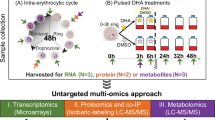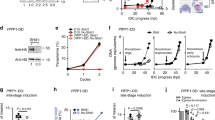Abstract
The origin of all mitochondria can be traced to the symbiotic arrangement that resulted in the emergence of eukaryotes in a world that was exclusively populated by prokaryotes1,2,3. This arrangement, however, has been in continuous genetic flux: the varying degrees of gene loss and transfer from the mitochondrial genome in different eukaryotic lineages seem to signify an ongoing ‘conflict’ between the host and the symbiont. Eukaryotic parasites belonging to the phylum Apicomplexa provide an excellent example to support this view. These organisms contain the smallest mitochondrial genomes known4,5, with an organization that differs among various genera; one genus, Cryptosporidium, seems to have lost the entire mitochondrial genome6,7. Here we show that erythrocytic stages of the human malaria parasite Plasmodium falciparum seem to maintain an active mitochondrial electron transport chain to serve just one metabolic function: regeneration of ubiquinone required as the electron acceptor for dihydroorotate dehydrogenase, an essential enzyme for pyrimidine biosynthesis. Transgenic P. falciparum parasites expressing Saccharomyces cerevisiae dihydroorotate dehydrogenase, which does not require ubiquinone as an electron acceptor8, were completely resistant to inhibitors of mitochondrial electron transport. Maintenance of mitochondrial membrane potential, however, was essential in these parasites, as indicated by their hypersensitivity to proguanil, a drug that collapsed the membrane potential in the presence of electron transport inhibitors. Thus, acquisition of just one enzyme can render mitochondrial electron transport nonessential in erythrocytic stages of P. falciparum.
This is a preview of subscription content, access via your institution
Access options
Subscribe to this journal
Receive 51 print issues and online access
$199.00 per year
only $3.90 per issue
Buy this article
- Purchase on Springer Link
- Instant access to full article PDF
Prices may be subject to local taxes which are calculated during checkout



Similar content being viewed by others
References
Martin, W. & Müller, M. The hydrogen hypothesis for the first eukaryote. Nature 392, 37–41 (1998)
Embley, T. M. & Martin, W. Eukaryotic evolution, changes and challenges. Nature 440, 623–630 (2006)
Lane, N. Power, Sex, Suicide: Mitochondria and the Meaning of Life (Oxford Univ. Press, New York, 2005)
Vaidya, A. B. & Arasu, P. Tandemly arranged gene clusters of malarial parasites that are highly conserved and transcribed. Mol. Biochem. Parasitol. 22, 249–257 (1987)
Vaidya, A. B., Akella, R. & Suplick, K. Sequences similar to genes for two mitochondrial proteins and portions of ribosomal RNA in tandemly arrayed 6-kilobase-pair DNA of a malarial parasite. Mol. Biochem. Parasitol. 35, 97–107 (1989)
Xu, P. et al. The genome of Cryptosporidium hominis. Nature 431, 1107–1112 (2004)
Abrahamsen, M. S. et al. Complete genome sequence of the apicomplexan, Cryptosporidium parvum. Science 304, 441–445 (2004)
Nagy, M., Lacroute, F. & Thomas, D. Divergent evolution of pyrimidine biosynthesis between anaerobic and aerobic yeasts. Proc. Natl Acad. Sci. USA 89, 8966–8970 (1992)
Wilson, R. J. & Williamson, D. H. Extrachromosomal DNA in the Apicomplexa. Microbiol. Mol. Biol. Rev. 61, 1–16 (1997)
Wilson, R. J. Progress with parasite plastids. J. Mol. Biol. 319, 257–274 (2002)
Vaidya, A. B., Lashgari, M. S., Pologe, L. G. & Morrisey, J. Structural features of Plasmodium cytochrome b that may underlie susceptibility to 8-aminoquinolines and hydroxynaphthoquinones. Mol. Biochem. Parasitol. 58, 33–42 (1993)
Fry, M., Webb, E. & Pudney, M. Effect of mitochondrial inhibitors on adenosinetriphosphate levels in Plasmodium falciparum. Comp. Biochem. Physiol. B 96, 775–782 (1990)
Gardner, M. J. et al. Genome sequence of the human malaria parasite Plasmodium falciparum. Nature 419, 498–511 (2002)
Vaidya, A. B. & Mather, M. W. A. Post-genomic view of the mitochondrion in malaria parasites. Curr. Top. Microbiol. Immunol. 295, 233–250 (2005)
Fry, M. & Pudney, M. Site of action of the antimalarial hydroxynaphthoquinone, 2-[trans-4-(4'-chlorophenyl) cyclohexyl]-3-hydroxy-1,4-naphthoquinone (566C80). Biochem. Pharmacol. 43, 1545–1553 (1992)
Vaidya, A. B. in Malaria: Parasite biology, Pathogenesis, and Protection (ed. Sherman, I. W.) 355–368 (ASM Press, Washington DC, 1998)
Gutteridge, W. E., Dave, D. & Richards, W. H. Conversion of dihydroorotate to orotate in parasitic protozoa. Biochim. Biophys. Acta 582, 390–401 (1979)
Gojkovic, Z. et al. Horizontal gene transfer promoted evolution of the ability to propagate under anaerobic conditions in yeasts. Mol. Genet. Genomics 271, 387–393 (2004)
O'Donnell, R. A. et al. A genetic screen for improved plasmid segregation reveals a role for Rep20 in the interaction of Plasmodium falciparum chromosomes. EMBO J. 21, 1231–1239 (2002)
Vaidya, A. B. & Mather, M. W. Atovaquone resistance in malaria parasites. Drug Resist. Updat. 3, 283–287 (2000)
Baldwin, J. et al. High-throughput screening for potent and selective inhibitors of Plasmodium falciparum dihydroorotate dehydrogenase. J. Biol. Chem. 280, 21847–21853 (2005)
Srivastava, I. K. & Vaidya, A. B. A mechanism for the synergistic antimalarial action of atovaquone and proguanil. Antimicrob. Agents Chemother. 43, 1334–1339 (1999)
Nicholls, D. G. & Ferguson, S. J. Bioenergetics 3 (Academic Press, London, 2002)
Allen, R. J. & Kirk, K. The membrane potential of the intraerythrocytic malaria parasite Plasmodium falciparum. J. Biol. Chem. 279, 11264–11272 (2004)
Striepen, B. et al. Gene transfer in the evolution of parasite nucleotide biosynthesis. Proc. Natl Acad. Sci. USA 101, 3154–3159 (2004)
Keithly, J. S., Langreth, S. G., Buttle, K. F. & Mannella, C. A. Electron tomographic and ultrastructural analysis of the Cryptosporidium parvum relict mitochondrion, its associated membranes, and organelles. J. Eukaryot. Microbiol. 52, 132–140 (2005)
Lill, R. & Muhlenhoff, U. Iron–sulfur-protein biogenesis in eukaryotes. Trends Biochem. Sci. 30, 133–141 (2005)
Giraud, M. F. & Velours, J. The absence of the mitochondrial ATP synthase delta subunit promotes a slow growth phenotype of rho- yeast cells by a lack of assembly of the catalytic sector F1 . Eur. J. Biochem. 245, 813–818 (1997)
Schnaufer, A., Clark-Walker, G. D., Steinberg, A. G. & Stuart, K. The F1-ATP synthase complex in bloodstream stage trypanosomes has an unusual and essential function. EMBO J. 24, 4029–4040 (2005)
van der Giezen, M. & Tovar, J. Degenerate mitochondria. EMBO Rep. 6, 525–530 (2005)
Acknowledgements
We thank our colleagues within the Center for Molecular Parasitology, especially J. Burns and B. Bergman, for discussions, advice, and general cheer; K. Henry for providing yeast strains; and B. A. Palfey (University of Michigan) for communicating that the Type 1A DHOD is not inhibited by proguanil. This work was supported by grants from the National Institute of Allergy and Infectious Diseases to A.B.V.
Author information
Authors and Affiliations
Corresponding author
Ethics declarations
Competing interests
Reprints and permissions information is available at www.nature.com/reprints. The authors declare no competing financial interests.
Supplementary information
Supplementary Information
This file contains Supplementary Figures S1-S4 with Legends, Supplementary Methods, and additional references. (PDF 547 kb)
Rights and permissions
About this article
Cite this article
Painter, H., Morrisey, J., Mather, M. et al. Specific role of mitochondrial electron transport in blood-stage Plasmodium falciparum. Nature 446, 88–91 (2007). https://doi.org/10.1038/nature05572
Received:
Accepted:
Issue Date:
DOI: https://doi.org/10.1038/nature05572
This article is cited by
-
Purifying selection leads to low protein diversity of the mitochondrial cyt b gene in avian malaria parasites
BMC Ecology and Evolution (2023)
-
Intracellular development and impact of a marine eukaryotic parasite on its zombified microalgal host
The ISME Journal (2022)
-
In vitro maturation of Toxoplasma gondii bradyzoites in human myotubes and their metabolomic characterization
Nature Communications (2022)
-
Artemisinin resistance in the malaria parasite, Plasmodium falciparum, originates from its initial transcriptional response
Communications Biology (2022)
-
Composition and stage dynamics of mitochondrial complexes in Plasmodium falciparum
Nature Communications (2021)
Comments
By submitting a comment you agree to abide by our Terms and Community Guidelines. If you find something abusive or that does not comply with our terms or guidelines please flag it as inappropriate.



